Normalization of Fetal Cerebral and Hepatic Iron by Parental Iron Therapy to Pregnant Rats with Systemic Iron Deficiency without Anemia
Abstract
:1. Introduction
2. Materials and Methods
2.1. Gestational Fe Deficiency
2.2. Metal Analyses
2.3. Gene Expression Analyses
2.4. Statistics
3. Results
4. Discussion
4.1. Fe and Fe-Related Genes in Offspring on P0
4.2. Fe and Fe-Related Genes in Offspring on P70
4.3. The Effect of ID and Fe Therapy on Cu Levels
4.4. The Effect of ID and Fe Therapy on Zn Levels
5. Conclusions
Author Contributions
Funding
Institutional Review Board Statement
Informed Consent Statement
Data Availability Statement
Acknowledgments
Conflicts of Interest
References
- Zimmermann, M.B.; Hurrell, R.F. Nutritional iron deficiency. Lancet 2007, 370, 511–520. [Google Scholar] [CrossRef]
- Heath, A.L.; Fairweather-Tait, S.J. Clinical implications of changes in the modern diet: Iron intake, absorption and status. Best Pract. Res. Clin. Haematol. 2002, 15, 225–241. [Google Scholar] [CrossRef] [PubMed]
- Scholl, T.O. Iron status during pregnancy: Setting the stage for mother and infant. Am. J. Clin. Nutr. 2005, 81, 1218S–1222S. [Google Scholar] [CrossRef] [PubMed]
- Zariwala, M.G.; Somavarapu, S.; Farnaud, S.; Renshaw, D. Comparison study of oral iron preparations using a human intestinal model. Sci. Pharm. 2013, 81, 1123–1139. [Google Scholar] [CrossRef] [PubMed]
- Froessler, B.; Collingwood, J.; Hodyl, N.A.; Dekker, G. Intravenous ferric carboxymaltose for anaemia in pregnancy. BMC Pregnancy Childbirth 2014, 14, 115. [Google Scholar] [CrossRef] [PubMed]
- Laskey, J.; Webb, I.; Schulman, H.M.; Ponka, P. Evidence that transferrin supports cell proliferation by supplying iron for DNA synthesis. Exp. Cell Res. 1988, 176, 87–95. [Google Scholar] [CrossRef]
- Lozoff, B.; Jimenez, E.; Hagen, J.; Mollen, E.; Wolf, A.W. Poorer behavioral and developmental outcome more than 10 years after treatment for iron deficiency in infancy. Pediatrics 2000, 105, E51. [Google Scholar] [CrossRef]
- Levy, J.E.; Jin, O.; Fujiwara, Y.; Kuo, F.; Andrews, N.C. Transferrin receptor is necessary for development of erythrocytes and the nervous system. Nat. Genet. 1999, 21, 396–399. [Google Scholar] [CrossRef]
- Jefferies, W.A.; Brandon, M.R.; Hunt, S.V.; Williams, A.F.; Gatter, K.C.; Mason, D.Y. Transferrin receptor on endothelium of brain capillaries. Nature 1984, 312, 162–163. [Google Scholar] [CrossRef]
- Focht, S.J.; Snyder, B.S.; Beard, J.L.; Van Gelder, W.; Williams, L.R.; Connor, J.R. Regional distribution of iron, transferrin, ferritin, and oxidatively-modified proteins in young and aged Fischer 344 rat brains. Neuroscience 1997, 79, 255–261. [Google Scholar] [CrossRef]
- Zheng, W.; Monnot, A.D. Regulation of brain iron and copper homeostasis by brain barrier systems: Implication in neurodegenerative diseases. Pharmacol. Ther. 2012, 133, 177–188. [Google Scholar] [CrossRef] [PubMed]
- Skjørringe, T.; Burkhart, A.; Johnsen, K.B.; Moos, T. Divalent metal transporter 1 (DMT1) in the brain: Implications for a role in iron transport at the blood-brain barrier, and neuronal and glial pathology. Front. Mol. Neurosci. 2015, 8, 19. [Google Scholar] [CrossRef]
- Zhang, D.L.; Hughes, R.M.; Ollivierre-Wilson, H.; Ghosh, M.C.; Rouault, T.A. A ferroportin transcript that lacks an iron-responsive element enables duodenal and erythroid precursor cells to evade translational repression. Cell Metab. 2009, 9, 461–473. [Google Scholar] [CrossRef] [PubMed]
- Darshan, D.; Frazer, D.M.; Wilkins, S.J.; Anderson, G.J. Severe iron deficiency blunts the response of the iron regulatory gene Hamp and pro-inflammatory cytokines to lipopolysaccharide. Haematologica 2010, 95, 1660–1667. [Google Scholar] [CrossRef] [PubMed]
- Urrutia, P.; Aguirre, P.; Esparza, A.; Tapia, V.; Mena, N.P.; Arredondo, M.; Gonzalez-Billault, C.; Nunez, M.T. Inflammation alters the expression of DMT1, FPN1 and hepcidin, and it causes iron accumulation in central nervous system cells. J. Neurochem. 2013, 126, 541–549. [Google Scholar] [CrossRef]
- Burkhart, A.; Skjørringe, T.; Johnsen, K.B.; Siupka, P.; Thomsen, L.B.; Nielsen, M.S.; Moos, T. Expression of iron-related proteins at the neurovascular unit supports reduction and reoxidation of iron for transport through the blood-brain barrier. Mol. Neurobiol. 2016, 53, 7237–7253. [Google Scholar] [CrossRef]
- Bastian, T.W.; Prohaska, J.R.; Georgieff, M.K.; Anderson, G.W. Perinatal iron and copper deficiencies alter neonatal rat circulating and brain thyroid hormone concentrations. Endocrinology 2010, 151, 4055–4065. [Google Scholar] [CrossRef]
- Monnot, A.D.; Behl, M.; Ho, S.; Zheng, W. Regulation of brain copper homeostasis by the brain barrier systems: Effects of Fe-overload and Fe-deficiency. Toxicol. Appl. Pharmacol. 2011, 256, 249–257. [Google Scholar] [CrossRef]
- Oladiji, T. Tissue levels of iron, copper, zinc and magnesium in iron deficient rats. Biokemistri 2003, 14, 75–81. [Google Scholar]
- Myers, S.A.; Nield, A.; Myers, M. Zinc transporters, mechanisms of action and therapeutic utility: Implications for type 2 diabetes mellitus. J. Nutr. Metab. 2012, 2012, 173712. [Google Scholar] [CrossRef]
- Jahn, M.R.; Andreasen, H.B.; Futterer, S.; Nawroth, T.; Schunemann, V.; Kolb, U.; Hofmeister, W.; Munoz, M.; Bock, K.; Meldal, M.; et al. A comparative study of the physicochemical properties of iron isomaltoside 1000 (Monofer), a new intravenous iron preparation and its clinical implications. Eur. J. Pharm. Biopharm. 2011, 78, 480–491. [Google Scholar] [CrossRef] [PubMed]
- Auerbach, M.; Henry, D.; Derman, R.J.; Achebe, M.M.; Thomsen, L.L.; Glaspy, J. A prospective, multi-center, randomized comparison of iron isomaltoside 1000 versus iron sucrose in patients with iron deficiency anemia; the FERWON-IDA trial. Am. J. Hematol. 2019, 94, 1007–1014. [Google Scholar] [CrossRef] [PubMed]
- Wolf, M.; Rubin, J.; Achebe, M.; Econs, M.J.; Peacock, M.; Imel, E.A.; Thomsen, L.L.; Carpenter, T.O.; Weber, T.; Brandenburg, V.; et al. Effects of Iron Isomaltoside vs Ferric Carboxymaltose on Hypophosphatemia in Iron-Deficiency Anemia: Two Randomized Clinical Trials. JAMA 2020, 323, 432–443. [Google Scholar] [CrossRef] [PubMed]
- Unger, E.L.; Earley, C.J.; Thomsen, L.L.; Jones, B.C.; Allen, R.P. Effects of IV iron isomaltoside-1000 treatment on regional brain iron status in an iron-deficient animal. Neuroscience 2013, 246, 179–185. [Google Scholar] [CrossRef] [PubMed]
- Karakoc, Y.; Buruk, M.S.; Aktan, B.; Kirvar, R.; Erdogan, S.; Sahbaz, M.A.; Aksoy, S.; Gulyasar, T. Effects of chronic light/dark cycle on iron zinc and copper levels in different brain regions of rats. Biol. Trace Elem. Res. 2011, 144, 1003–1007. [Google Scholar] [CrossRef]
- Stephansen, D.A.; Nielsen, A.H.; Hvitved-Jacobsen, T.; Arias, C.A.; Brix, H.; Vollertsen, J. Distribution of metals in fauna, flora and sediments of wet detention ponds and natural shallow lakes. Ecol. Eng. 2014, 66, 43–51. [Google Scholar] [CrossRef]
- Bustin, S.A.; Benes, V.; Garson, J.A.; Hellemans, J.; Huggett, J.; Kubista, M.; Mueller, R.; Nolan, T.; Pfaffl, M.W.; Shipley, G.L.; et al. The MIQE guidelines: Minimum information for publication of quantitative real-time PCR experiments. Clin. Chem. 2009, 55, 611–622. [Google Scholar] [CrossRef]
- Pfaffl, M.W. A new mathematical model for relative quantification in real-time RT-PCR. Nucleic Acids Res. 2001, 29, e45. [Google Scholar] [CrossRef]
- Piñero, D.J.; Li, N.Q.; Connor, J.R.; Beard, J.L. Variations in dietary iron alter brain iron metabolism in developing rats. J. Nutr. 2000, 130, 254–263. [Google Scholar] [CrossRef]
- Lozoff, B.; Georgieff, M.K. Iron deficiency and brain development. Semin. Pediatr. Neurol. 2006, 13, 158–165. [Google Scholar] [CrossRef]
- Felt, B.T.; Beard, J.L.; Schallert, T.; Shao, J.; Aldridge, J.W.; Connor, J.R.; Georgieff, M.K.; Lozoff, B. Persistent neurochemical and behavioral abnormalities in adulthood despite early iron supplementation for perinatal iron deficiency anemia in rats. Behav. Brain Res. 2006, 171, 261–270. [Google Scholar] [CrossRef] [PubMed]
- Rao, R.; Tkac, I.; Schmidt, A.T.; Georgieff, M.K. Fetal and neonatal iron deficiency causes volume loss and alters the neurochemical profile of the adult rat hippocampus. Nutr. Neurosci. 2011, 14, 59–65. [Google Scholar] [CrossRef] [PubMed]
- Mihaila, C.; Schramm, J.; Strathmann, F.G.; Lee, D.L.; Gelein, R.M.; Luebke, A.E.; Mayer-Pröschel, M. Identifying a window of vulnerability during fetal development in a maternal iron restriction model. PLoS ONE 2011, 6, e17483. [Google Scholar] [CrossRef] [PubMed]
- Zhang, Q.; Lu, X.M.; Zhang, M.; Yang, C.Y.; Lv, S.Y.; Li, S.F.; Zhong, C.Y.; Geng, S.S. Adverse effects of iron deficiency anemia on pregnancy outcome and offspring development and intervention of three iron supplements. Sci. Rep. 2021, 11, 1347. [Google Scholar] [CrossRef] [PubMed]
- Moos, T.; Skjørringe, T.; Thomsen, L.L. Iron deficiency and iron treatment in the fetal developing brain—A pilot study introducing an experimental rat model. Reprod. Health 2018, 15, 93–120. [Google Scholar] [CrossRef]
- Ham, S.Y.; Jun, J.H.; Kim, H.B.; Shim, J.K.; Lee, G.; Kwak, Y.L. Regulators impeding erythropoiesis following iron supplementation in a clinically relevant rat model of iron deficiency anemia with inflammation. Life Sci. 2022, 310, 121124. [Google Scholar] [CrossRef]
- De Souza, L.V.; Hoffmann, A.; Fischer, C.; Petzer, V.; Asshoff, M.; Theurl, I.; Tymoszuk, P.; Seifert, M.; Brigo, N.; Hilbe, R.; et al. Comparative analysis of oral and intravenous iron therapy in rat models of inflammatory anemia and iron deficiency. Haematologica 2023, 108, 135–149. [Google Scholar] [CrossRef]
- Camaschella, C.; Pagani, A.; Silvestri, L.; Nai, A. The mutual crosstalk between iron and erythropoiesis. Int. J. Hematol. 2022, 116, 182–191. [Google Scholar] [CrossRef]
- Evstatiev, R.; Bukaty, A.; Jimenez, K.; Kulnigg-Dabsch, S.; Surman, L.; Schmid, W.; Eferl, R.; Lippert, K.; Scheiber-Mojdehkar, B.; Kvasnicka, H.M.; et al. Iron deficiency alters megakaryopoiesis and platelet phenotype independent of thrombopoietin. Am. J. Hematol. 2014, 89, 524–529. [Google Scholar] [CrossRef]
- Gambling, L.; Lang, C.; McArdle, H.J. Fetal regulation of iron transport during pregnancy. Am. J. Clin. Nutr. 2011, 94, S1903–S1907. [Google Scholar] [CrossRef]
- Morgan, E.H.; Moos, T. Mechanism and developmental changes in iron transport across the blood-brain barrier. Dev. Neurosci. 2002, 24, 106–113. [Google Scholar] [CrossRef] [PubMed]
- Moos, T.; Morgan, E.H. A morphological study of the developmentally regulated transport of iron into the brain. Dev. Neurosci. 2002, 24, 99–105. [Google Scholar] [CrossRef] [PubMed]
- Wang, X.; Wiesinger, J.; Beard, J.; Felt, B.; Menzies, S.; Earley, C.; Allen, R.; Connor, J. Thy1 expression in the brain is affected by iron and is decreased in Restless Legs Syndrome. J. Neurol. Sci. 2004, 220, 59–66. [Google Scholar] [CrossRef] [PubMed]
- Ozen, M.; Kitase, Y.; Vasan, V.; Burkhardt, C.; Ramachandra, S.; Robinson, S.; Jantzie, L.L. Chorioamnionitis Precipitates Perinatal Alterations of Heme-Oxygenase-1 (HO-1) Homeostasis in the Developing Rat Brain. Int. J. Mol. Sci. 2021, 22, 5773. [Google Scholar] [CrossRef] [PubMed]
- Georgieff, M.K.; Krebs, N.F.; Cusick, S.E. The Benefits and Risks of Iron Supplementation in Pregnancy and Childhood. Annu. Rev. Nutr. 2019, 39, 121–146. [Google Scholar] [CrossRef]
- Clardy, S.L.; Wang, X.; Zhao, W.; Liu, W.; Chase, G.A.; Beard, J.L.; True Felt, B.; Connor, J.R. Acute and chronic effects of developmental iron deficiency on mRNA expression patterns in the brain. In Oxidative Stress and Neuroprotection; Journal of Neural Transmission. Supplementa; Springer: Berlin/Heidelberg, Germany, 2006; pp. 173–196. [Google Scholar] [CrossRef]
- Ortiz, E.; Pasquini, J.M.; Thompson, K.; Felt, B.; Butkus, G.; Beard, J.; Connor, J.R. Effect of manipulation of iron storage, transport, or availability on myelin composition and brain iron content in three different animal models. J. Neurosci. Res. 2004, 77, 681–689. [Google Scholar] [CrossRef]
- Markova, V.; Holm, C.; Pinborg, A.B.; Thomsen, L.L.; Moos, T. Impairment of the Developing Human Brain in Iron Deficiency: Correlations to Findings in Experimental Animals and Prospects for Early Intervention Therapy. Pharmaceuticals 2019, 12, 120. [Google Scholar] [CrossRef]
- Lakhal-Littleton, S.; Wolna, M.; Carr, C.A.; Miller, J.J.; Christian, H.C.; Ball, V.; Santos, A.; Diaz, R.; Biggs, D.; Stillion, R.; et al. Cardiac ferroportin regulates cellular iron homeostasis and is important for cardiac function. Proc. Natl. Acad. Sci. USA 2015, 112, 3164–3169. [Google Scholar] [CrossRef]
- Vanlandewijck, M.; He, L.; Mäe, M.A.; Andrae, J.; Ando, K.; Del Gaudio, F.; Nahar, K.; Lebouvier, T.; Laviña, B.; Gouveia, L.; et al. A molecular atlas of cell types and zonation in the brain vasculature. Nature 2018, 554, 475–480. [Google Scholar] [CrossRef]
- Wilkinson, N.; Pantopoulos, K. The IRP/IRE system in vivo: Insights from mouse models. Front. Pharmacol. 2014, 5, 176. [Google Scholar] [CrossRef]
- Hansen, T.M.; Nielsen, H.; Bernth, N.; Moos, T. Expression of ferritin protein and subunit mRNAs in normal and iron deficient rat brain. Brain Res. Mol. Brain Res. 1999, 65, 186–197. [Google Scholar] [CrossRef] [PubMed]
- Han, J.; Day, J.R.; Connor, J.R.; Beard, J.L. H and L ferritin subunit mRNA expression differs in brains of control and iron-deficient rats. J. Nutr. 2002, 132, 2769–2774. [Google Scholar] [CrossRef] [PubMed]
- Ma, J.; Guo, Q.; Shen, M.Q.; Li, W.; Zhong, Q.X.; Qian, Z.M. Apolipoprotein E is required for brain iron homeostasis in mice. Redox Biol. 2023, 64, 102779. [Google Scholar] [CrossRef] [PubMed]
- Wu, Q.; Hao, Q.; Li, H.; Wang, B.; Wang, P.; Jin, X.; Yu, P.; Gao, G.; Chang, Y.Z. Brain iron deficiency and affected contextual fear memory in mice with conditional Ferroportin1 ablation in the brain. FASEB J. Off. Publ. Fed. Am. Soc. Exp. Biol. 2021, 35, e21174. [Google Scholar] [CrossRef] [PubMed]
- McMillen, S.A.; Nonnecke, E.B.; Lönnerdal, B. Trace Element Interactions, Inflammatory Signaling, and Male Sex Implicated in Reduced Growth Following Excess Oral Iron Supplementation in Pre-Weanling Rats. Nutrients 2022, 14, 3913. [Google Scholar] [CrossRef]
- Penkowa, M.; Nielsen, H.; Hidalgo, J.; Bernth, N.; Moos, T. Distribution of metallothionein I + II and vesicular zinc in the developing central nervous system: Correlative study in the rat. J. Comp. Neurol. 1999, 412, 303–318. [Google Scholar] [CrossRef]
- McCarthy, R.C.; Kosman, D.J. Glial cell ceruloplasmin and hepcidin differentially regulate iron efflux from brain microvascular endothelial cells. PLoS ONE 2014, 9, e89003. [Google Scholar] [CrossRef]
- McCarthy, R.C.; Kosman, D.J. Mechanisms and regulation of iron trafficking across the capillary endothelial cells of the blood-brain barrier. Front. Mol. Neurosci. 2015, 8, 31. [Google Scholar] [CrossRef]
- Sherman, A.R.; Tissue, N.T. Tissue iron, copper and zinc levels in offspring of iron-sufficient and iron-deficient rats. J. Nutr. 1981, 111, 266–275. [Google Scholar] [CrossRef]
- Skjørringe, T.; Møller, L.B.; Moos, T. Impairment of interrelated iron- and copper homeostatic mechanisms in brain contributes to the pathogenesis of neurodegenerative disorders. Front. Pharmacol. 2012, 3, 169. [Google Scholar] [CrossRef]
- Gambling, L.; Andersen, H.S.; Czopek, A.; Wojciak, R.; Krejpcio, Z.; McArdle, H.J. Effect of timing of iron supplementation on maternal and neonatal growth and iron status of iron-deficient pregnant rats. J. Physiol. 2004, 561, 195–203. [Google Scholar] [CrossRef] [PubMed]
- Carmona, A.; Chen, S.; Domart, F.; Choquet, D.; Ortega, R. Imaging the structural organization of chemical elements in growth cones of developing hippocampal neurons. Met. Integr. Biometal Sci. 2022, 14, mfab073. [Google Scholar] [CrossRef] [PubMed]
- Lenartowicz, M.; Kennedy, C.; Hayes, H.; McArdle, H.J. Transcriptional regulation of copper metabolism genes in the liver of fetal and neonatal control and iron-deficient rats. Biometals 2015, 28, 51–59. [Google Scholar] [CrossRef] [PubMed]
- Basha, M.R.; Wei, W.; Bakheet, S.A.; Benitez, N.; Siddiqi, H.K.; Ge, Y.W.; Lahiri, D.K.; Zawia, N.H. The fetal basis of amyloidogenesis: Exposure to lead and latent overexpression of amyloid precursor protein and beta-amyloid in the aging brain. J. Neurosci. 2005, 25, 823–829. [Google Scholar] [CrossRef]
- Nam, H.; Knutson, M.D. Effect of dietary iron deficiency and overload on the expression of ZIP metal-ion transporters in rat liver. Biometals 2012, 25, 115–124. [Google Scholar] [CrossRef]
- Solomons, N.W. Competitive interaction of iron and zinc in the diet: Consequences for human nutrition. J. Nutr. 1986, 116, 927–935. [Google Scholar] [CrossRef]
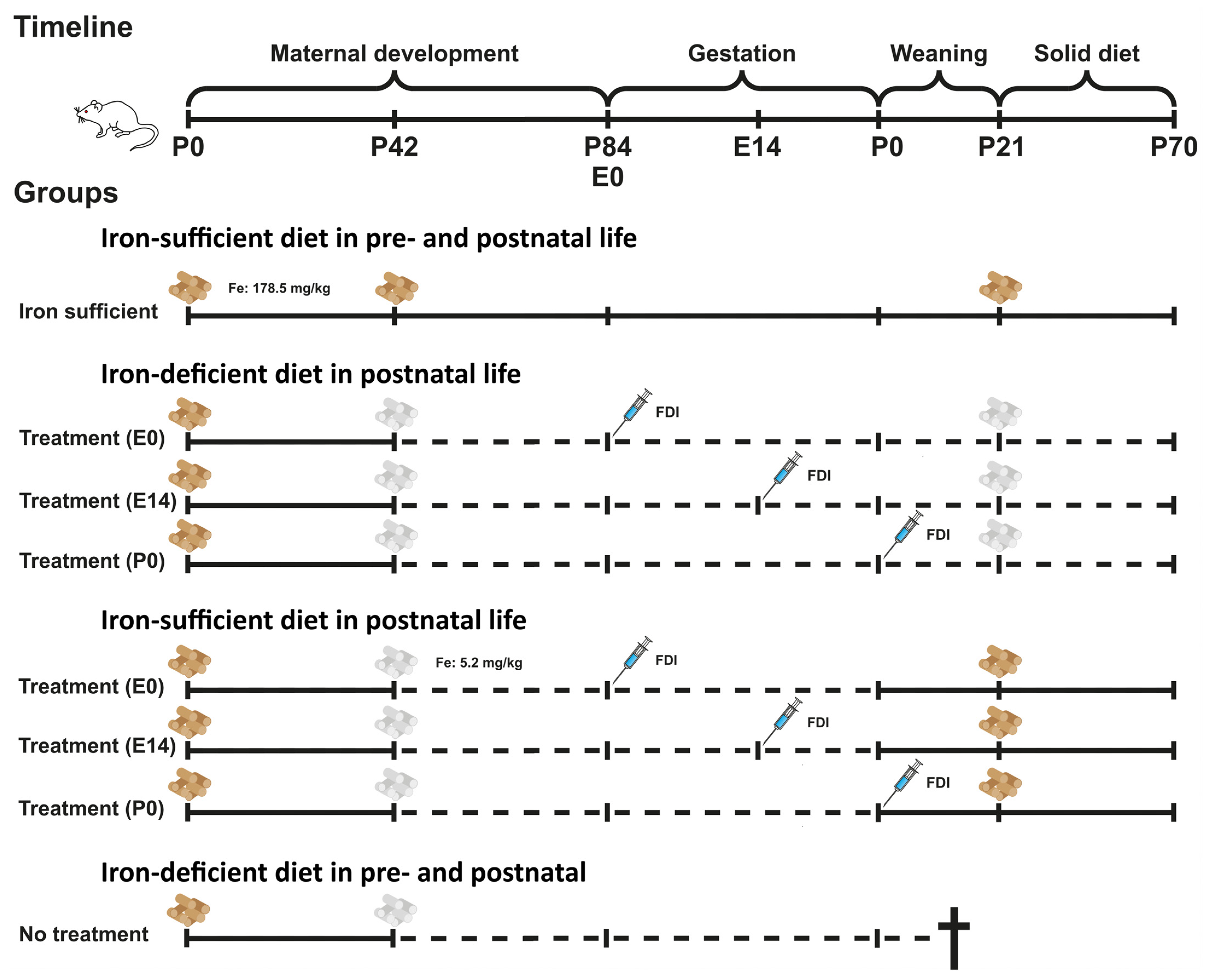

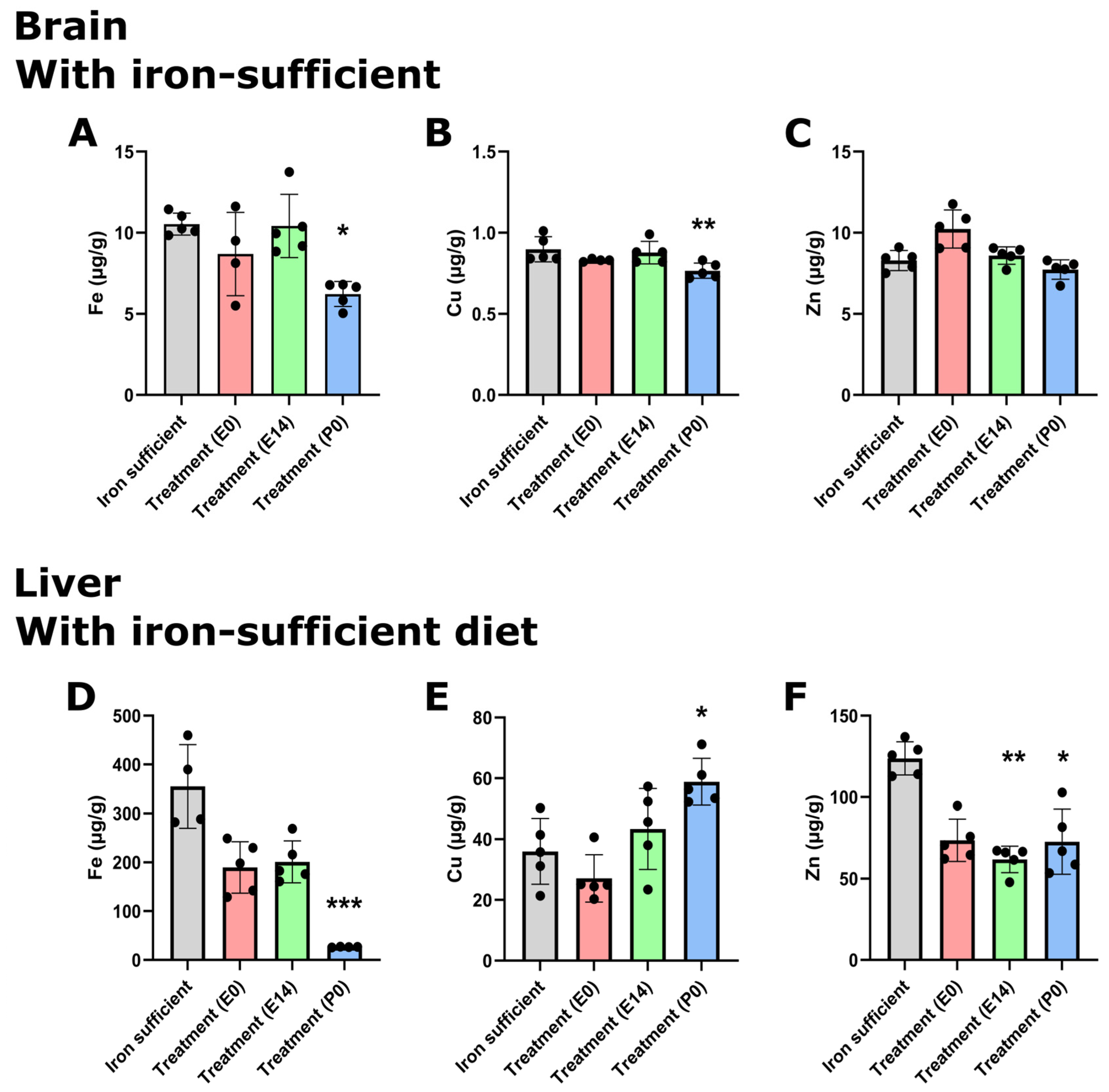
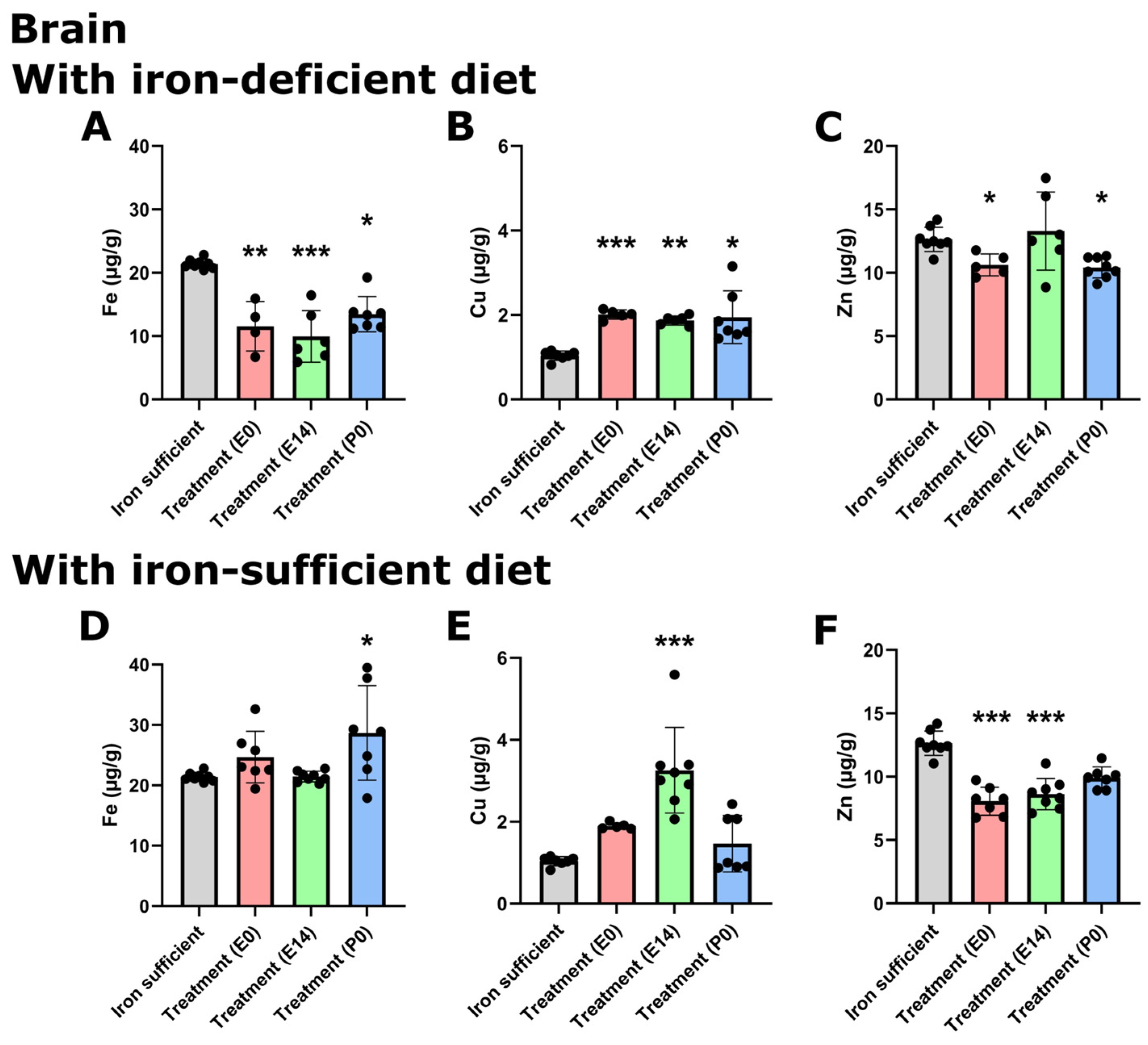
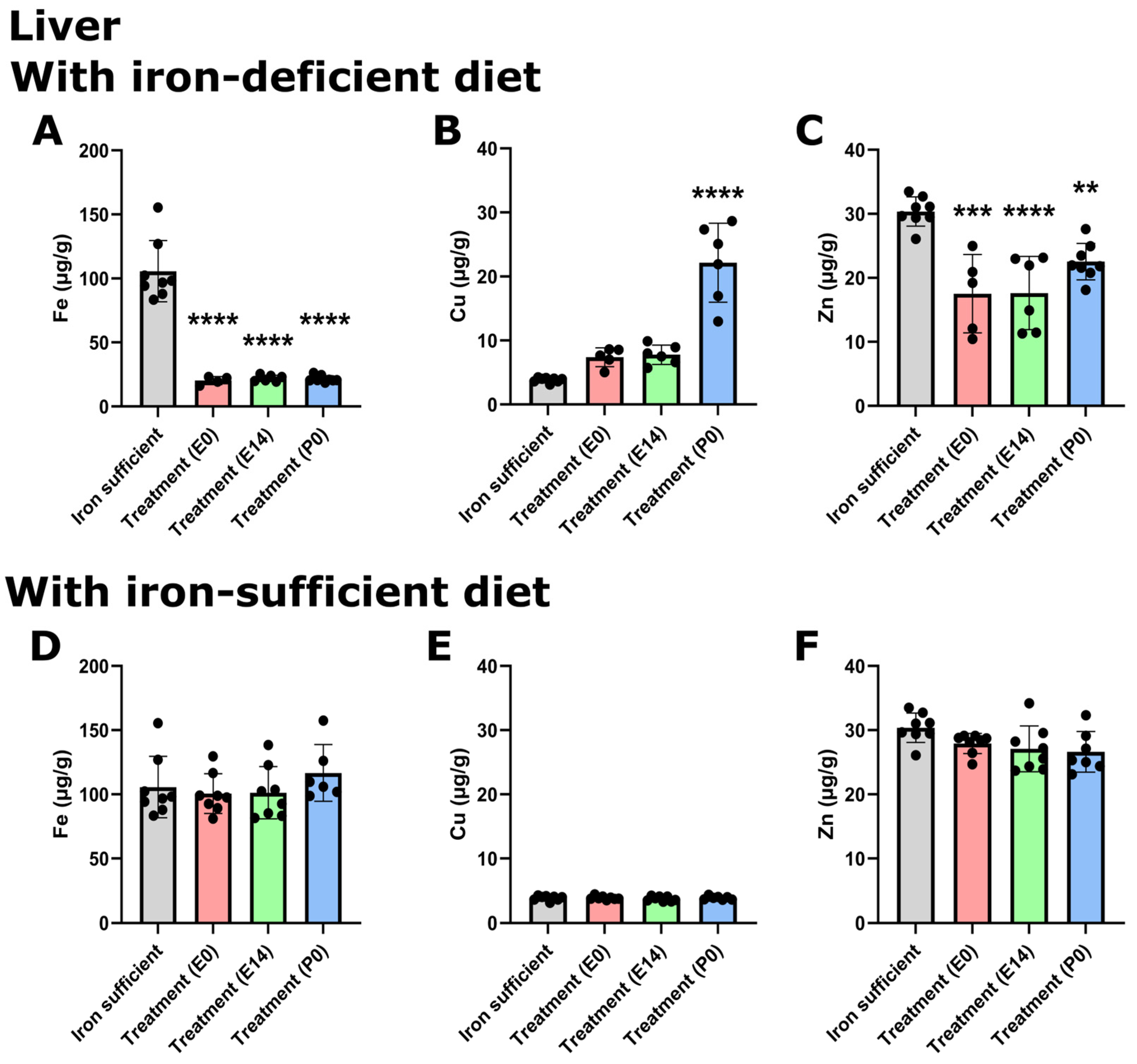
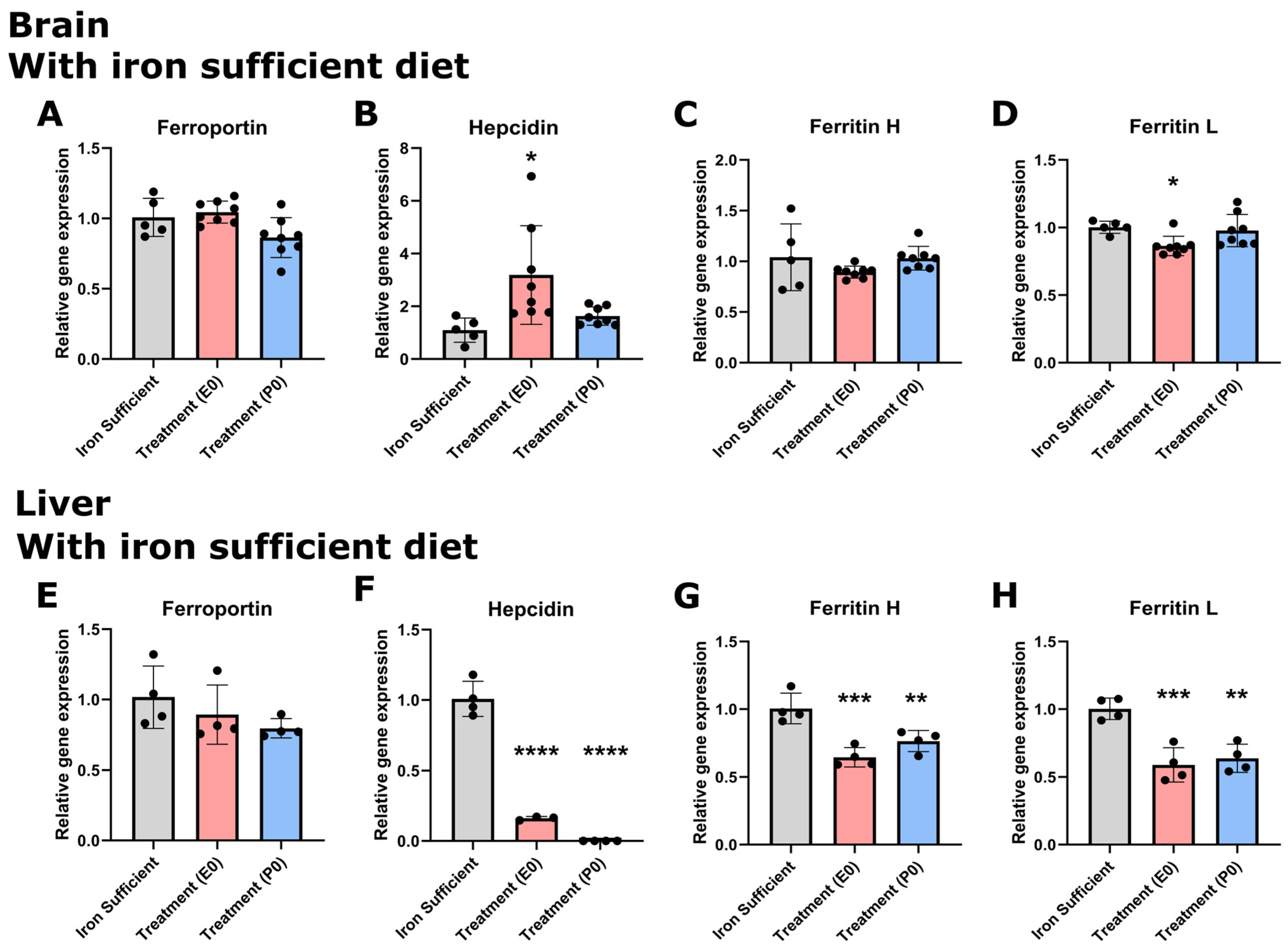


| Pregnant Females | Weight | Hepatic Fe | Plasma Fe | HgB | Hepatic Cu | Hepatic Zn |
|---|---|---|---|---|---|---|
| (g) | (µg/g) | (µg/g) | (mmol/l) | (µg/g) | (µg/g) | |
| Iron-sufficient diet | 221.3 ± 5.1 | 214.6 ± 22.5 | 460.3 ± 42.0 | 8.6 ± 0.4 | 2.7 ± 0.7 | 18.7 ± 5.5 |
| Iron-deficient diet | 237.4 ± 5.8 | 151.3 ± 24.2 * | 461.5 ± 14.2 | 8.3 ± 0.5 | 2.9 ± 0.9 | 17.8 ± 5.2 |
| Weight | HGB | MCV | MCHC | Reticulocytes | Leucocytes | Thrombocytes |
|---|---|---|---|---|---|---|
| (g) | (mmol/L) | (fL) | (mmol/L) | (×109/L) | (×109/L) | (×109/L) |
| (1) Iron sufficient: | ||||||
| 275 ± 5.4 | 8.9 ± 0.2 | 59.1 ± 0.8 | 20 ± 0.1 | 227.7 ± 6.8 | 4.8 ± 0.9 | 615.5 ± 51.6 |
| (II) Continuously iron-deficient diet with a single intramuscular injection of ferric derisomaltoside given on | ||||||
| E0 | ||||||
| 235.3 ± 4.7 ** | 3 ± 0.2 *** | 39.7 ± 0.7 *** | 11.3 ± 0.2 *** | 1773 ± 121 **** | 3.9 ± 0.8 | 891.4 ± 12.6 *** |
| E14 | ||||||
| 258.1 ± 7.6 | 3 ± 0.2 *** | 39.7 ± 0.3 *** | 11.8 ± 0.1 *** | 1380 ± 67.7 *** | 3.4 ± 0.5 | 912.2 ± 50.9 *** |
| P0 | ||||||
| 213.3 ± 9.7 *** | 3.7 ± 0.1 *** | 40.6 ± 0.4 *** | 12 ± 0.2 *** | 1591 ± 169.1 **** | 5.7 ± 0.7 | 911.3 ± 43.9 *** |
| (III) Iron-deficient diet + Iron-containing diet after weaning. Single intramuscular injection of ferric derisomaltoside given on | ||||||
| E0 | ||||||
| 272 ± 3.5 | 8.8 ± 0.1 | 59.8 ± 0.3 | 19.6 ± 0.2 | 256.2 ± 12.1 | 2.8 ± 1.1 | 588.3 ± 56.1 |
| E14 | ||||||
| 264.6 ± 4.9 | 9.3 ± 0.3 | 59.8 ± 1.3 | 19.5 ± 0.3 | 275.8 ± 9.8 | 4 ± 0.4 | 586.7 ± 74.4 |
| P0 | ||||||
| 256 ± 8.1 | 9 ± 0.2 | 62 ± 1.0 * | 19.3 ± 0.2 | 286.2 ± 19 | 4.8 ± 0.8 | 580 ± 35.6 |
Disclaimer/Publisher’s Note: The statements, opinions and data contained in all publications are solely those of the individual author(s) and contributor(s) and not of MDPI and/or the editor(s). MDPI and/or the editor(s) disclaim responsibility for any injury to people or property resulting from any ideas, methods, instructions or products referred to in the content. |
© 2024 by the authors. Licensee MDPI, Basel, Switzerland. This article is an open access article distributed under the terms and conditions of the Creative Commons Attribution (CC BY) license (https://creativecommons.org/licenses/by/4.0/).
Share and Cite
Burkhart, A.; Johnsen, K.B.; Skjørringe, T.; Nielsen, A.H.; Routhe, L.J.; Hertz, S.; Møller, L.B.; Thomsen, L.L.; Moos, T. Normalization of Fetal Cerebral and Hepatic Iron by Parental Iron Therapy to Pregnant Rats with Systemic Iron Deficiency without Anemia. Nutrients 2024, 16, 3264. https://doi.org/10.3390/nu16193264
Burkhart A, Johnsen KB, Skjørringe T, Nielsen AH, Routhe LJ, Hertz S, Møller LB, Thomsen LL, Moos T. Normalization of Fetal Cerebral and Hepatic Iron by Parental Iron Therapy to Pregnant Rats with Systemic Iron Deficiency without Anemia. Nutrients. 2024; 16(19):3264. https://doi.org/10.3390/nu16193264
Chicago/Turabian StyleBurkhart, Annette, Kasper Bendix Johnsen, Tina Skjørringe, Asbjørn Haaning Nielsen, Lisa Juul Routhe, Sandra Hertz, Lisbeth Birk Møller, Lars Lykke Thomsen, and Torben Moos. 2024. "Normalization of Fetal Cerebral and Hepatic Iron by Parental Iron Therapy to Pregnant Rats with Systemic Iron Deficiency without Anemia" Nutrients 16, no. 19: 3264. https://doi.org/10.3390/nu16193264









